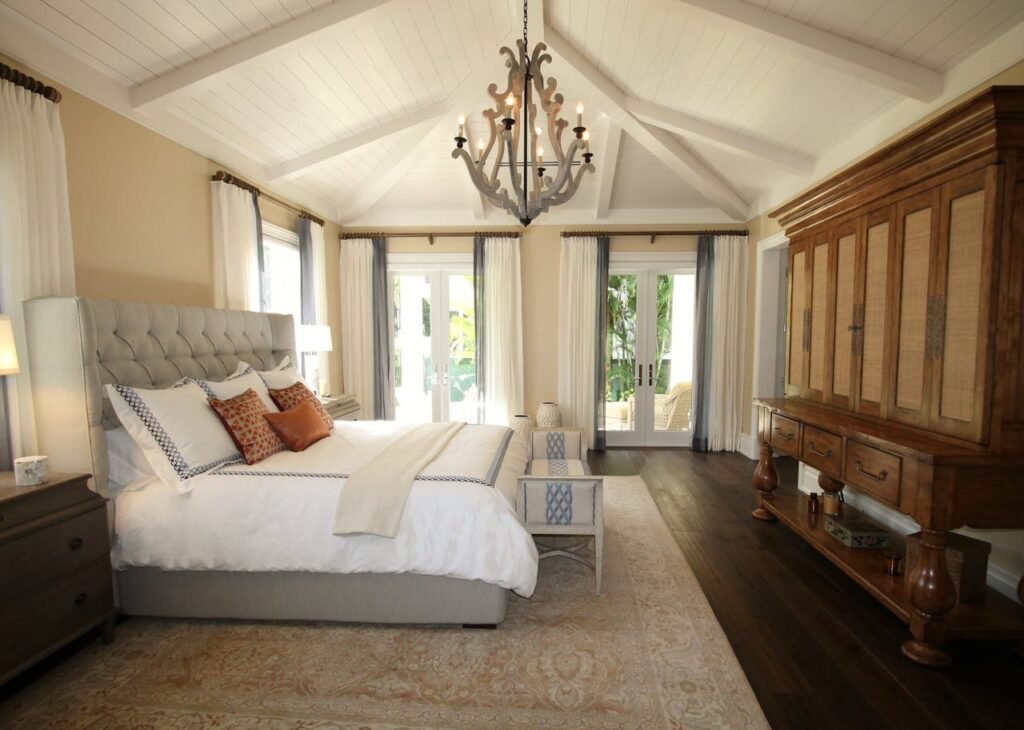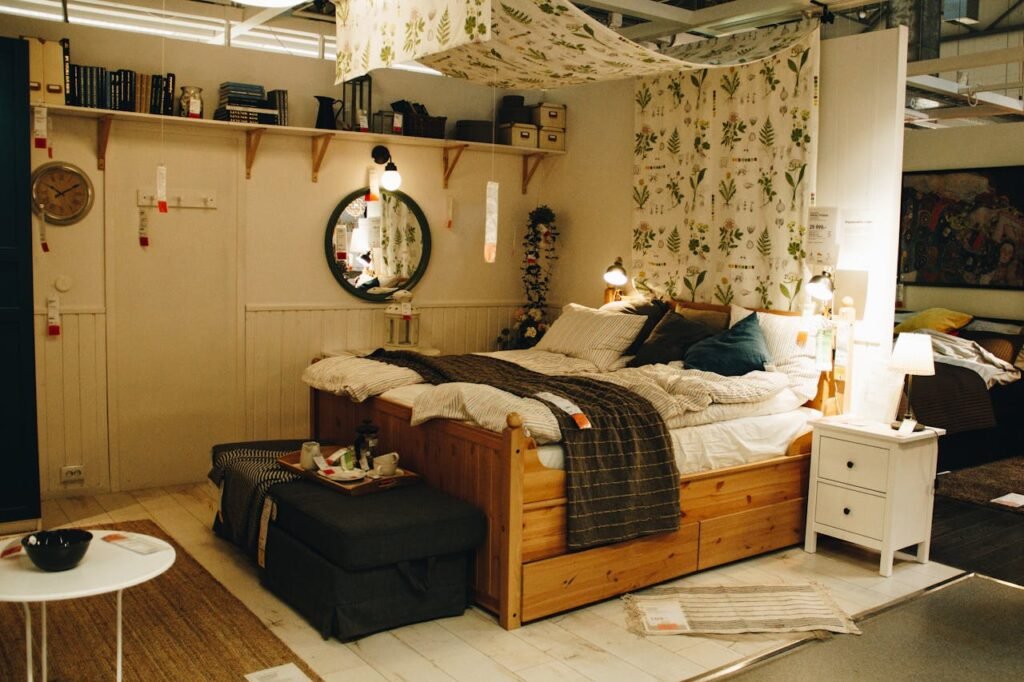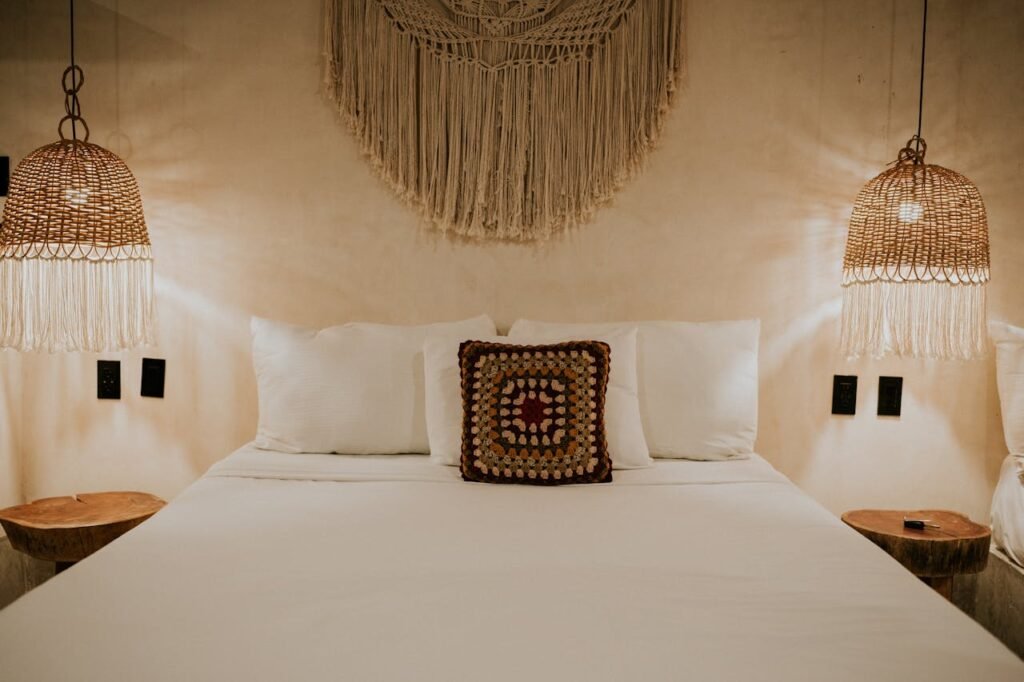Your bedroom is much more than just a place to sleep: it’s a sanctuary where you relax, rejuvenate, and escape from daily stress. Creating an aesthetically pleasing bedroom that promotes relaxation requires careful consideration of various design elements. This comprehensive guide explores ten essential components that will transform your bedroom into a haven of peace, allowing you to rest peacefully and wake up refreshed.
1. Calming Color Palette
The colors you choose for your bedroom significantly influence its atmosphere and your state of mind. Selecting the right palette is the foundation of a peaceful space.
- Soothing neutrals: Soft whites, gentle beiges, and light grays create a timeless, serene backdrop that promotes tranquility
- Cool tones: Muted blues and gentle greens evoke peace and harmony, helping to create a relaxing atmosphere
- Warm earthy shades: Soft olive, taupe, and sand colors can add warmth while maintaining a calming environment
- Accent colors: For visual interest, incorporate subtle accents in muted yellows or blush pinks to add dimension without overwhelming the space
When selecting colors, remember that personal preference matters: choose shades that resonate with your sense of comfort and peace to ensure a truly personalized retreat.

2. Luxurious and Comfortable Bedding
Since your bed is the centerpiece of your room, investing in quality bedding is essential for both visual appeal and comfort.
- Quality Mattress: Invest in a high-quality, supportive mattress that ensures optimal comfort and enhances your sleep experience.
- Soft and Breathable Fabrics: Choose natural fibers like cotton or linen with a high thread count for sheets, duvet covers, and pillowcases.
- Layering Strategy: Create depth with multiple textures by incorporating:
- A plush comforter or duvet cover
- Several pillows of varying sizes
- A soft throw blanket at the foot of the bed
- Seasonal Adaptability: Consider lighter options for summer and warmer, cozy bedding for the winter months.
Remember that your bedding isn’t just about aesthetics—it directly affects your sleep quality and overall well-being, making it worth the investment.
3. Ambient and Layered Lighting
Proper lighting creates ambiance and significantly influences the atmosphere of your bedroom. A well-designed lighting scheme should be versatile enough to adapt to different activities and times of day.
- Soft, warm lighting: Incorporate light fixtures that emit a soft golden glow to create a cozy atmosphere (ideally with a color temperature of around 2700 K)
- Layered approach: Include multiple light sources:
- Dimmable overhead lighting for general illumination
- Bedside lamps for reading
- Task lighting for specific activities
- Accent lighting to highlight architectural features or artwork
- Natural light: Maximize natural light with appropriate window treatments that control glare throughout the day.
- Smart solutions: Consider programmable lighting switches or dimmers that fit your needs and routine.
This careful combination of light sources allows you to customize the ambiance based on your activities and mood, enhancing the tranquil environment of your bedroom.

4. Tranquil Decor and Accessories
The right decorative elements can enhance the tranquil atmosphere of your bedroom while reflecting your personal style.
- Minimalist approach: Embrace simplicity by focusing on a few carefully chosen pieces instead of cluttering surfaces.
- Nature-inspired artwork:Select relaxing images such as landscapes, botanical prints, or abstract pieces in soothing colors.
- Meaningful objects: Only display items that bring you joy or have special meaning.
- Balance and proportion: Consider the scale of decorative elements in relation to your furniture and the size of the room.
When choosing decor, ask yourself if each piece contributes to the sense of tranquility you’re seeking to create. If not, it might be better to store it elsewhere or display it in another room of your home.
5. Smart Storage Solutions
A tidy environment is essential for mental clarity and relaxation. Implementing effective storage solutions helps maintain order and serenity.
- Customized closet systems: Install organizational systems that maximize space efficiency and provide designated areas for clothing, shoes, and accessories.
- Under-bed storage: Use this often overlooked space for seasonal items or extra bedding.
- Multifunctional furniture: Choose pieces that offer hidden storage, such as ottomans, benches, or beds with drawers.
- Vertical solutions: Incorporate floating shelves or wall-mounted organizers to free up floor space.
The key to effective storage is creating a place for everything, keeping frequently used items easily accessible. This organizational approach reduces visual distractions and promotes a sense of calm.
6. Natural Elements and Plants
Incorporating elements of nature into your bedroom creates a connection to the outdoors and enhances the serene quality of the space.
- Indoor plants: Add purifying plants like snake plants, pothos, or peace lilies to improve air quality and introduce living elements
- Natural materials: Incorporate wood, stone, rattan, or bamboo through furniture and decorative items
- Botanical motifs: Consider subtle nature-inspired patterns in textiles or artwork
- Water features: Small tabletop fountains can add gentle sound and movement for additional relaxation
These natural elements ground the space and create a harmonious environment that promotes rest and rejuvenation.
7. Comfortable and Functional Furniture
Selecting the right furniture contributes significantly to both the aesthetic appeal and functionality of your bedroom retreat.
- Quality bed frame: Choose a sturdy, well-designed frame that complements your decorating style.
- Proportional nightstands: Select nightstands that provide adequate surface area and storage space for essentials.
- Seating option: If space permits, include a comfortable chair or small bench to create a reading nook or dressing area.
- Clean lines: Opt for furniture with simple, uncluttered designs that promote visual calm.
When arranging furniture, make sure it is evenly distributed throughout the room, allowing for easy movement and creating a sense of spaciousness and order.
8. Personalized Touches
Maintaining a serene atmosphere, incorporating personal elements makes the space uniquely yours.
- Meaningful photographs: Display a few cherished photos in coordinating frames
- Handcrafted items: Include artisanal pieces that reflect your personality and add character
- Favorite books: Keep a small collection of books that bring you joy or relaxation
- Scent elements: Incorporate your preferred aromatherapy through diffusers, candles, or room sprays
These personal touches transform a well-designed bedroom into your personal sanctuary, making it a place where you feel completely at ease and at home.
9. Textural Elements and Layering
Adding a variety of textures creates depth, interest, and comfort to your bedroom space.
- Soft textiles: Combine plush rugs, velvet pillows, and knitted throws to create a tactile experience.
- Window treatments: Choose high-quality curtains or blinds that filter light beautifully and add texture.
- Wall treatments: Consider using textured wallpaper, wood paneling, or a fabric headboard to add dimension.
- Contrasting materials: Balance soft elements with harder surfaces like glass, metal, or polished wood for visual interest
This thoughtful layering of textures appeals to the senses and enhances the cozy, inviting quality of your bedroom sanctuary.

10. Creating Functional Zones
Designating specific areas within your bedroom for different activities improves both functionality and tranquility.
- Sleep zone: Place your bed away from doors and windows when possible, creating a sense of protection.
- Relaxation corner: If space permits, set up a comfortable reading or meditation corner.
- Dressing area: Designate a well-lit space near storage for dressing and grooming.
- Work space: If necessary, create a minimal, contained work area that can be closed off or put away.
By defining these zones, you create a natural flow and purpose within the room, making the space more functional while maintaining its peaceful essence.
Comparing Design Approaches
| Design Style | Color Palette | Key Materials | Decor Elements | Best For |
|---|---|---|---|---|
| Minimalist | Whites, grays, black accents | Glass, metal, polished surfaces | Few carefully chosen pieces, clean lines | Those who find simplicity calming |
| Natural/Organic | Earth tones, soft greens | Wood, stone, natural fibers | Plants, botanical art, handcrafted items | Nature lovers seeking groundedness |
| Soft Modern | Muted blues, soft pinks | Mixed textures, light woods | Subtle patterns, layered textiles | Those wanting balance of comfort and style |
| Classic/Timeless | Neutrals with subtle accents | Quality woods, brass, linen | Symmetrical arrangements, traditional art | People who appreciate enduring design |
Implementation Tips
To successfully transform your bedroom into a tranquil retreat:
- Start with decluttering: Clear out unnecessary items before beginning your redesign
- Focus on quality over quantity: Invest in fewer, better pieces rather than many cheaper items
- Implement changes gradually: Transform your space in phases rather than all at once
- Maintain consistency: Ensure design elements work harmoniously together
- Reassess regularly: Periodically evaluate what’s working and what could be improved
Frequently Asked Questions
What are the most relaxing colors for a bedroom?
Soft blues, soothing greens, muted grays, and warm neutrals like beige and taupe are considered the most relaxing colors for bedrooms. However, personal preference plays a role: choose colors that make you feel calm and comfortable.
How can I create a calming bedroom on a budget?
First, focus on decluttering and reorganizing, then add a splash of color with fresh paint and new bedding. Incorporate DIY projects like refinishing furniture and purchasing quality secondhand pieces. Add plants and use textiles like pillows and throws to refresh the space affordably.
What is the best lighting for a relaxing bedroom?
Layered lighting with warm-toned bulbs (around 2700K) creates the most relaxing atmosphere. Include dimmable overhead lighting, adjustable bedside lamps, and perhaps some accent lighting. Avoid harsh, cool-toned lights, especially in the evening.
How can I incorporate technology without disrupting the tranquil atmosphere?
Keep technology to a minimum and contained: consider furniture with built-in charging stations, use cable management solutions, and establish tech-free zones in the bedroom. Choose devices with minimalist designs and consider setting a “digital sunset” time to turn off screens.
What are some easy ways to refresh my bedroom’s style seasonally?
Change the bedding, swap out throw pillows and blankets, rotate artwork, update the scents with seasonal aromatherapy, and incorporate seasonal plants or flowers. These simple changes can keep your space fresh year-round.
Conclusion
Creating a welcoming and aesthetically pleasing bedroom involves carefully considering the elements that promote tranquility, comfort, and personal connection. By incorporating these ten essential components—from a soothing color palette to functional zones—you can transform your bedroom into a sanctuary that promotes rest, renewal, and well-being.
Remember, your bedroom should reflect your personal definition of tranquility. Whether you prefer minimalist simplicity or multi-layered comfort, the most important thing is to create a space where you feel calm and at ease. With these guidelines as a foundation, you can design a bedroom that truly serves as your haven of peace.

